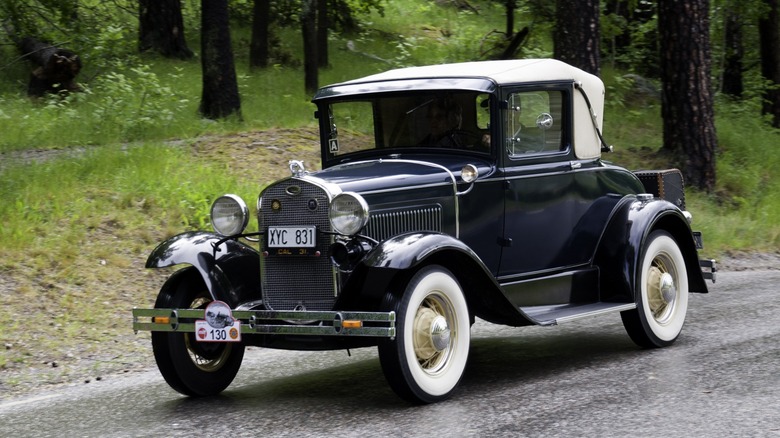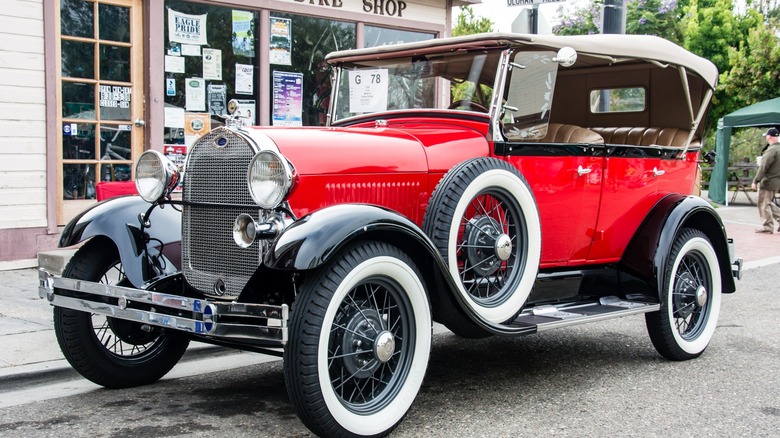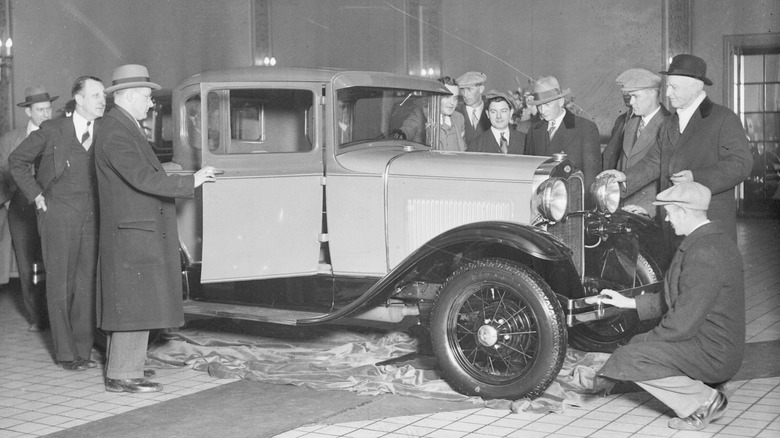Everything Ford Fans Should Know About The Model A
Ford produced about 15 million Model Ts in the 19 years between 1908 and mid-1927 before introducing the upscaled Model A to the world on December 2, 1927. It took several months to switch tooling from the Model T to production of the Model A at the Rogue, Ford's Dearborn, Michigan, factory.
If it seems odd that the Model A came after the Model T in Ford's automobile naming timeline, there's a good explanation. According to the corporate history archives, Henry Ford wanted to "wipe the slate clean and start all over with the Model A." Ford produced an earlier Model A from 1903 to 1904, but it was an open-air carriage easily distinguishable from the newer version.
While the Model T shared some similarities with its successor on the surface, such as its four-cylinder flathead engine, the Model A followed through with Ford's vision for a fresh start. The curvacious Model A is taller, wider, and longer than the Model T and features front and rear service brakes, chrome bumpers, a safety-glass windshield, and hydraulic shock absorbers.
The Model A's powertrain also vastly improved upon the Model T's, delivering twice as much horsepower and improving fuel economy. Instead of the 177-cubic-inch engine, the Model A featured a 200.5-cubic-inch flathead four-cylinder with 40 horsepower. The upgraded sliding-gear transmission added an additional gear for a total of three forward gears plus reverse. The improvements in Model A allowed it to reach a top speed of 65 mph.
Ford Model A variations
When Ford launched the Model A, it released seven body-type variations: Coupe, Fordor sedan, Phaeton, Roadster, Sport Coupe, Tudor sedan, and truck. Along with the body style options, Model A buyers had a choice between four exterior paint colors, including Arabian Sand, Dawn Gray, Gun Metal Blue, and Niagra Blue,
Ford made over 4.3 million Model A between its launch in December 1927 and early 1932 when production ended. Experts, like Hagerty Price Guide Support Specialist Hawk Hawkins, generally recognize three Model A generations. The separation between generations isn't as straightforward as for more modern cars, as changes occurred mid-cycle and were implemented randomly.
The first generation Model A includes those built from late 1927 to June 1928. The second generation includes Model As manufactured from mid-1928 through 1929 (Paul Newman's first car was a 1929 Model A), and third-gen Model As run from 1930 to the end of production in early 1932. Unique characteristics such as a red steering wheel on first-gen models and third-gen polished stainless steel radiator shells made identification more manageable in the 1930s. However, as people swapped parts between Model As to restore them, they became difficult to distinguish.
Buying a Model A today
It's still possible to buy a Model A today. According to the Petersen Automotive Museum, decreased Model A interest over the last few years resulted in stable prices. Model A body styles such as the Town Car, Cabriolet, Convertible sedan, and Phaeton command the highest prices due to their scarcity.
The least expensive drivable Model A listed on Hemmings is a 1930 Sedan. A private seller offers to sell the tan over olive green Model A for $10,500, but that price is negotiable. Photos on the listing show a complete car with the original flathead four-cylinder engine design, and a video lets you see and hear it as it drives past. It even comes with a trunk attached to the rear that allows bringing enough clothes for a long road trip.
At the high end of the spectrum is a customized 1930 Model A Pickup listed for sale by Streetside Classics – Atlanta for $115,995. This street rod features bright red exterior paint, a tan leather interior, a big-block V8 with aluminum heads, a four-speed automatic transmission, and four-wheel power disc brakes. While very little remains of the original Model A, it still represents the 1930s style.
Between those extremes lie hundreds of Model As of varying quality and price all across the country. Will your Model A be a project car that needs a lot of tender loving care, a fully restored classic, or a ground-pounding street rod?


